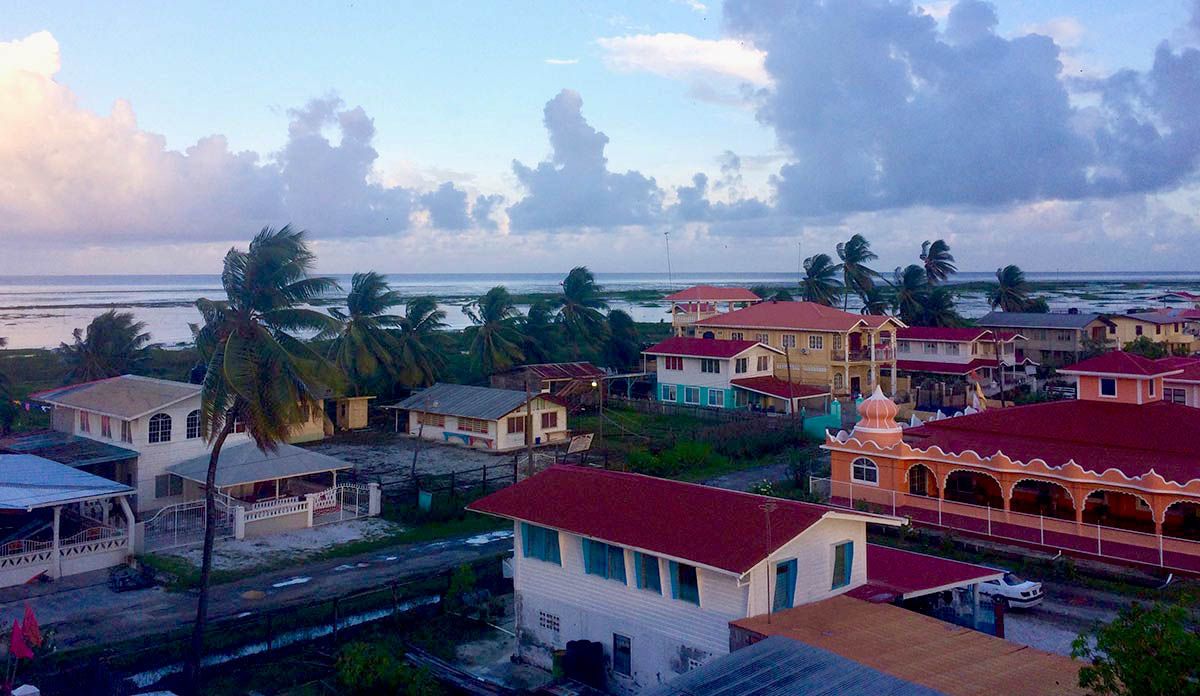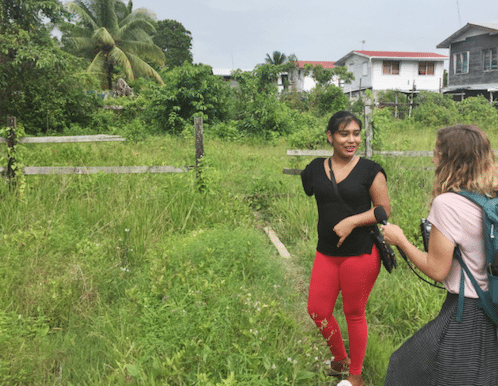Compassion is an emotional reaction to the suffering of others combined with a desire to relieve that suffering. It can be uncomfortable. Sometimes it even hurts. And as humans, our complex self-defense mechanisms are designed to dull the kinds of pain that come from bearing witness to trauma.
For those who work in the field of public health, compassion seems to be an inevitable—and even necessary—catalyst for addressing challenges of human suffering. So what do we do when our compassion suddenly seems to disappear?
Detachment and delayed reactions
I sat cross-legged in my hotel room on a plain white bed surrounded by plain white walls, staring blankly at the television. Family Guy was on TV. I cursed the broken air conditioner, ate my fried chicken, and drank a Banks, the local cheap beer. My only thoughts, when they came, were, “Shouldn’t I be in a puddle on the floor right now? Or at least writing furiously to get all of my thoughts on paper? Where are all the thoughts? What’s wrong with me?”
A few hours earlier, we had hugged 24-year-old Natasha Houston goodbye at the end of the dirt walkway to her mom’s house. She waved with her left hand as we got into the taxi. Her right hand was gone, along with her right arm, all the way to her shoulder. She had just given us a tour of her mother’s backyard, where she once lived with her two children and abusive husband, Richard. She explained that in 2013, she had finally tried to leave him after seven years. But in a drunken rage, Richard locked them in the house and began sharpening his cutlass.
“I know it’s a normal routine that he sharpen his cutlass in the afternoon for work in the morning,” Houston told us. “And while I’m stirring the porridge for the baby, I had a feel—this hand started burning, my right arm, started burning.”
Richard murdered Natasha’s two children, and attempted to kill her. Police found him in the field behind their house nearly a month later, dead from an apparent suicide. Natasha has physical therapy once a week to learn to use her prosthetic arm, but she says she still relives the scene in her dreams again and again.
During the three weeks we spent reporting in the small Caribbean country of Guyana, my colleague, Campbell Rawlins, and I heard many stories with similar themes: domestic violence, murder, suicide, substance abuse. We had traveled there on a grant from the Pulitzer Center for Crisis Reporting to look into the risk factors behind the nation’s suicide rate—in 2014, the World Health Organization had ranked them highest in the world.
The realities of this suicide rate, 44.2 per 100,00 deaths, were readily apparent. We were welcomed into countless homes and offices and introduced to more contacts than we could possibly meet in three weeks. Anyone to whom we told the reason for our travels had a story, either first- or second-hand, or both.
After each interview, I had a similar thought to the ones I was having in the hotel room that night. Why do I feel so numb?
Flash forward three weeks. I’m back in Boston, finally sitting down to my kitchen table after employing every procrastination tactic I could think of to avoid working. I have sloppy tears smeared all over my face as I listen to a thirty-second clip of Natasha’s interview. The next day, I am overcome with exhaustion and can’t bring myself to leave my apartment. After that, I spend two days with a feeling of nearly debilitating angst at every man I come across or read about in the news. I cycle through emotions so fast I’m not sure how to handle myself.
Luckily, my feeling of relative numbness and subsequent emotional rollercoaster were short-lived. But I have also felt them in the past during particularly heavy lectures—detachment and delayed reactions. To be sure, they are usually joined by feelings of invigoration and total fascination. But as a student of public health, and after only two semesters of this, I imagine a lifetime of tackling issues like these. Globally and domestically, the numbers are dire—how many stories like Natasha’s will I hear?
Compassion fatigue and vicarious traumatization
While grappling with this question, I thought about the job I had as an outreach worker for homeless and at-risk young adults the year before starting graduate school. During the job interview, one of the questions I was asked was, “What is your self-care routine?”
I had never been asked this kind of question before, especially not during an interview. I asked for clarification.
My future boss restated the question. “What do you do for fun when you’re not at work?”
I answered that I liked running and hiking, going to the beach with my dog, cooking myself dinner to Frank Sinatra—things that felt like second nature.
“Good,” my future boss replied. “If you work here, those things will be more important than ever.”
My co-workers and I had a workshop during my first week about compassion fatigue, also known as secondary traumatic stress syndrome, “a natural but disruptive by-product of working with traumatized clients.” In other words, by working with vulnerable populations, we become privy to others’ trauma. It is a privilege to gain trust and hear someone’s story, but it can also be mentally and emotionally wearing.
Post-traumatic stress disorder was added to the third edition of the Diagnostic and Statistical Manual in 1980. Since then, many studies have explored the effects of working with trauma survivors, but most are concentrated within fields readily defined as “helping professions,” such as psychotherapy and social work.
According to the American Counseling Association, symptoms of “vicarious trauma” can manifest for counselors in many ways: exhaustion, irritability, going out to avoid being alone, apathy, avoidance of job responsibilities, over-eating or under-eating, feelings of numbness towards others’ trauma, to name only a few.
However, many professionals in various fields use interviews to gather necessary information—journalism and public health, for instance—and may find themselves at an unrecognized risk for similar reactions.
Trauma is all around us
One of the themes we kept hearing during our time in Guyana was that children never learn to cope with pervasive stress. According to lawyer, advocate, and mental health consultant Anthony Autar, issues like domestic violence and suicide have become so normalized and mental illness so stigmatized in Guyana that it is difficult for people to reach out for services.
“I think it’s safe to say that more than a quarter of this country is suffering from undiagnosed PTSD,” Autar says. “When you’re in Guyana you think what you’re going through is normal. And you come out of it, and you go to a more developed country where this is not normal. That’s when you realize, maybe I need to go see a psychiatrist or something.”
The state of mental health and interpersonal violence in Guyana is dire, but what about in a more developed country—for example, the United States? Here, certain states are actually experiencing similar rates of domestic violence and suicide. The WHO’s most recent data shows Guyana’s suicide rates have fallen to 29 per 100,000. As of 2015, Wyoming is the state with the highest suicide rate in the United States, with a rate of 28.24 per 100,000 deaths attributable to suicide. In Guyana, 142 women have been murdered by domestic partners since 2010, at an average rate of 2.7 per 100,000 deaths per year. According to the Violence Policy Center’s annual “When Men Murder Women” report, in 2014, Alaska had the highest rate with 3.15 women per 100,000 murders. Louisiana was second highest, at 2.15 per 100,000 murders. The report says that at least 9 out of 10 women are murdered by someone they know.
Self-care: enlisting help for the helpers
With statistics like these, mental health has become a more explicit focus—at the local, national, and international levels—for organizations like the National Alliance on Mental Illness and the World Health Organization, and in the United Nations Sustainable Development Goals initiative. Celebrities like Justin Bieber and Sinead O’Connor, as well as hits like 13 Reasons Why and S-Town, are bringing issues like mental health and suicide into the pop culture spotlight.
A more open dialogue surrounding mental health is a step forward. But it also means that, more and more, public health workers—and many other professions—will encounter clients’ or research participants’ traumas, putting them on the front lines of a battle the fields of psychology and social work have been fighting for decades. While it is common for public health research to use statistics and quantitative data, the depth and complexity of mental health issues will likely also require the collection of qualitative data.
Researchers will have to confront trauma, putting them at risk of compassion fatigue. Coping strategies like enlisting social supports, exercising, practicing mindfulness, reaching out to therapists, and maintaining a good work-life balance have been shown to reduce symptoms of secondary traumatic stress. And as the saying goes, laughter really is good mental health medicine—humor is an effective coping mechanism and facilitates healing.
Like many counselors I know, I recently decided to seek professional help as part of my own self-care regimen. I checked the DocFind search engine for Boston University’s student insurance program. Within 5 miles of my zip code, there are 1,515 behavioral health professionals. My co-pay for behavioral health visits are only $10. (In Guyana, there are about 5 psychologists for a total national population of over 770,000 people, a massive disparity which deserves its own post.)
If the field of public health is going to tackle mental health more rigorously, as it should, self-care must join the curriculum at public health schools alongside already mainstream topics like epidemiology and healthy policy. As public health students, we learn from day one about the value of preventive health at the individual, interpersonal, community, and structural levels. But we must remember that preventive care is, as they say, a marathon (or, more accurately, an ultramarathon), not a sprint. Public health professionals cannot neglect their own health and self-care (and hydration—always hydration!) while we are out there in our various crusades.

